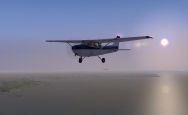| Briefing | May 2016 |
| Overview |
The May Event will be a tour of some of the major sites connected with Royal Engineers/Sappers:- |
| Start Time and Place |
The event may be flown on any day in May. |
| Airmanship | The majority of the route is under the London TMA which is class A airspace above 2500 ft, so maintaining the correct altitude will be very important. You must stay at or below 2400 ft under the TMA. |
| Weather ...or not | Before starting we will check the weather. If it is unsuitable for our trip as planned, then we will fix it. Something we can do in the simulator - wouldn't it be nice if we could do it in real life! For the general handling we need a cloud base that is at least 3000ft AGL. |
| What Aircraft can I fly |
Any aircraft can be flown in this event as long as it is within the EASA GA category. |
| Flight Plannong |
Your flight plan should show:
At 120 knots this Route should take about 1 hour 15 minutes. |
| Plan-G | The Plan-G files for this Event can be downloaded from HERE. |
| ATC |
At the time of publishing this event plan, ATC has not been confirmed. |
| Radio Discipline |
Take care not to let our Teamspeak chat cut across ATC. Stop any conversation immediately the R/T comes alive, then continue if "he wasn't talking to us". This is difficult because when transmitting on Teamspeak you can't hear the R/T. So be brief on Teamspeak, and be aware that ATC might be trying to get through. If anyone hears an R/T message which seems to be being ignored, just say "ATC is calling G-CIXN" if you have identified the callsign, or "ATC is calling us" which is a cue for everyone to be quiet on Teamspeak until ATC call again (which they will). Remember too that if asked to "Stand By" by ATC, you do not reply - not even "Roger", but simply wait until you are called again. Remember also that there are several different ATC frequencies in use, and you may not be able to hear when communications are taking place. Make sure you have set and know how to use a Teamspeak mute switch. |
| Background |
The Royal Engineers trace their origins back to the military engineers brought to England by William the Conqueror, specifically Bishop Gundulf of Rochester Cathedral, a talented military engineer, and claim over 900 years of unbroken service to the crown. On the 26th May 1716 by Warrant of King George I, the Engineers and the Artillery were placed on separate establishments and so the Corps of Royal Engineers was born, consisting entirely of commissioned officers. The manual work was done by the Artificer Companies, made up of contracted civilian artisans and labourers. In 1782, a Soldier Artificer Company was established for service in Gibraltar, and this was the first instance of non-commissioned military engineers. In 1787, the Corps of Engineers was granted the Royal prefix and adopted its current name and in the same year a Corps of Royal Military Artificers was formed, consisting of non-commissioned officers and privates, to be officered by the RE. Ten years later the Gibraltar Company, which had remained separate, was absorbed and in 1812 the name was changed to the Corps of Royal Sappers and Miners. In 1855 the Board of Ordnance was abolished and authority over the Royal Engineers, Royal Sappers and Miners and Royal Artillery was transferred to the Commander-in-Chief of the Forces, thus uniting them with the rest of the Army. The following year, the Royal Engineers and Royal Sappers and Miners became a unified corps as the Corps of Royal Engineers. The Monarch of the day is the true Colonel in Chief by decree and any individual that has earnt the right to wear the cap badge and colours, is entitled as an individual Royal servant, not as part of a Royal cohort (Corps of Royal...not Royal Corps of)! Sapper 300 commemorates this tercentenary anniversary through a series of country wide events, celebrating a remarkable and rich history of distinguished service throughout the world. In 1911 the Corps of Royal Engineers formed its Air Battalion (from the Balloon Battalion), the first flying unit of the British Armed Forces. The Air Battalion was the forerunner of the Royal Flying Corps and Royal Air Force. The RAF was founded on 1 April 1918 by the amalgamation of the Royal Flying Corps and the Royal Naval Air Service and was controlled by the British Government Air Ministry which had been established three months earlier. The Royal Flying Corps had been born out of the Air Battalion of the Royal Engineers and was under the control of the British Army. After the war, the RAF was greatly reduced in size and during the inter-war years it was used to "police" the British Empire. The RAF underwent rapid expansion prior to and during the Second World War. During the war it was responsible for the aerial defence of Great Britain, the strategic bombing campaign against Germany and tactical support to the British Army around the world. Whilst the British were not the first to make use of heavier-than-air military aircraft, the RAF is the world's oldest independent air force: that is, the first air force to become independent of army or navy control. |
| Acknowledgements | Event planning Dan Cooper Briefing: Max Symons. |
